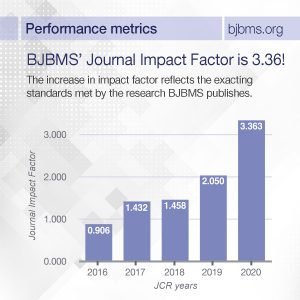
New Impact Factor (2020)
BJBMS’s Editorial team proudly announces that the Journal Impact Factor for BJBMS has again risen by more than 60% over the last year. The latest BJBMS’s Impact Factor (2020) is 3.363.
 The increase in impact factor reflects the exacting standards met by the research the journal publishes. The impact factor is determined using the number of citations received in that year by articles published in the journal during the two preceding years and is calculated by Clarivate Analytics (formerly known as Thomson Reuters), a recognized authority for evaluating the usefulness of a journal.
The increase in impact factor reflects the exacting standards met by the research the journal publishes. The impact factor is determined using the number of citations received in that year by articles published in the journal during the two preceding years and is calculated by Clarivate Analytics (formerly known as Thomson Reuters), a recognized authority for evaluating the usefulness of a journal.
The Association of Basic Medical Sciences would like to wholeheartedly thank the Editorial Board, authors, and all the reviewers for their ongoing support, tremendous hard work, and dedication. Their contribution ensures that BJBMS continues to receive a high-quality research material, enabling its community to advance medical research and education for the public benefit. BJBMS team will work hard in the future to become even better and to continue this rate of success.
What does BJBMS offer?
Broad readership and scope. The BJBMS reaches readers across a wide range of medical disciplines and sectors. The journal publishes basic and translational/clinical research submissions and reviews in all biomedical specialties, including Genetics and Molecular biology, Immunology, Microbiology, Pathology, Biochemistry, Pharmacology, Anatomy, Biomaterials, new and emerging research and diagnostic methods, new and emerging medical entities, and others.
Open access. All research is available to the public for free. The BJBMS deposits published articles in PubMed Central, which satisfies the NIH Public Access Policy and other similar funding agency requirements.
Editorial Board. Renowned international experts in the journal’s Editorial Board, together with external peer-reviewers, select the best submissions for publication.
High visibility. Open Access: articles are freely available to readers immediately after publication; highly accessed online content: more than 200,000 visitors/month (70,000 at PubMed Central (December 2020); 50,000 at Journal’s website (November 2020); more than 80,000 at Web of Science, Scopus, Google Scholar, and others); newsletters: more than 20,000 registered users receive a newsletter tailored to their field of interest; social media: articles are promoted through various social media channels (Twitter, LinkedIn, Facebook); advanced online: all accepted articles are published Advanced online and Ahead of print on PubMed within 3 days of acceptance, with citable DOIs, to make the article accessible as fast as possible; print circulation: 300 copies of print issues are sent to major libraries, institutes, universities, conferences, and subscribers worldwide. Get the free sample copy here; BJBMS Viewpoints: Journal’s blog that promotes authors and their research by publishing plain language summaries for a wide audience and media, video author summaries, as well as commentaries, interviews, news, and stories related to science and research.
Indexing and abstracting. SCIE (Science Citation Index Expanded), Web of Science, Clarivate Analytics; JCR (Journal Citation Reports®), Clarivate Analytics; PubMed/MEDLINE; PubMed Central (PMC); SCOPUS; SJR (Scimago Journal and Country Rank); DOAJ; SCILIT; EBSCO; PROQUEST; Dimensions; Semantic Scholar; Google Scholar; EMBASE/Excerpta Medica; Europe PubMed Central; Medscape; ROAD; HINARI; CAS; X-MOL; CNKI; many libraries.
Timely publication. The 2020 peer review performance metrics:
- Average time from submission to initial decision on rejection or peer review: 2 days
- Average peer-review time and decision: 19 days
- Average time from acceptance to (advanced online) publication: 3 days
- Rejections without peer review: 40%
- Acceptance Rate: 20%
Read more about the BJBMS.

Editor: Edna Skopljak, MD
Leave a Reply